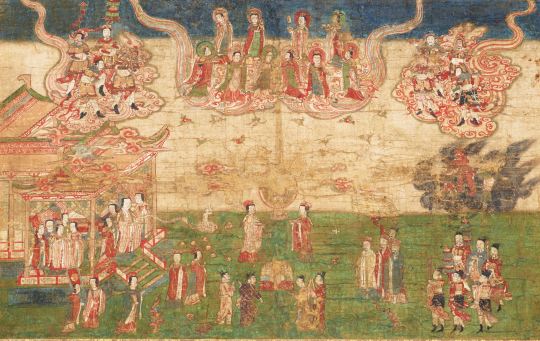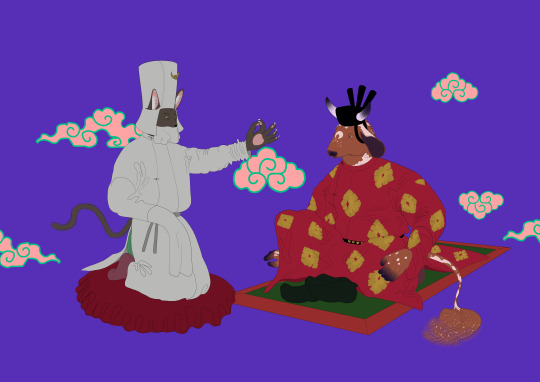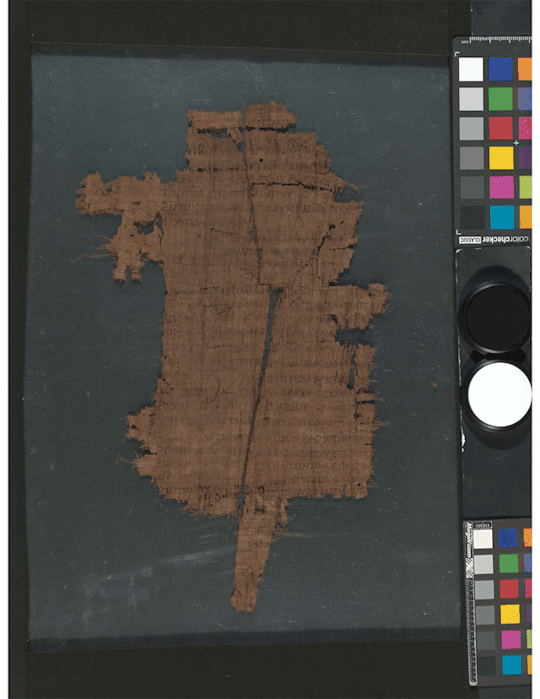#Manichaeism
Text

Depiction by an unknown Chinese artist of the birth of Mani (216-274 CE), founder of Manichaeism, a dualistic religion that portrays existence as a struggle between kingdoms of light and darkness. From its origins in present-day Iraq, Manichaeism spread westward into the Roman Empire (where it temporarily won over Augustine of Hippo before his conversion to Catholicism) and eastward into Asia. Though it died out in the West following intense persecution by the Christian Roman emperors, it is thought to have persisted in some parts of China into the 20th century, and perhaps still today.
Colors on silk, 35.6x56.9 cm (=14x22.4 in). 14th century (late Yuan or early Ming Dynasty). Now in the Kyushu National Museum, Dazaifu, Fukuoka Prefecture, Japan.
#art#art history#Asian art#China#Chinese art#Imperial China#Mani#Manichaeism#14th century art#Kyushu National Museum#religion#ancient religion#ancient history
47 notes
·
View notes
Text

gift art for @/alchemicalopu / psamtik on twitter of their sona Kavad converting mine to Manichaeism (meownichaeism), in the tarim basin sometime in the 10th century
13 notes
·
View notes
Text

Discovered on the Wiki page for "Manichaean art": I find this cave painting of the tree of life and the tree of death to be beautiful and haunting, but I can't for the life of me find any additional information about the mural or the cave, nor any other images aside from this photograph from 1998. The Wikipedia description says: Mural inside one of the Sengim-aghiz Caves (German: Sängim; traditional Chinese: 勝金口, pinyin: Shèngjīnkǒu; "Sengim-aghiz" is also referred to as Sengim Gorge) in Chinese Turkestan, depicting the Manichaean subjects of the Tree of Life and the Tree of Death. I guess "Chinese Turkestan" is an outdated term for the southwestern part of Xinjiang. I've wanted to go to Xinjiang since 2008, when I lived in Kunming (Yunnan, China) and enjoyed hanging out in the Uyghur part of town eating laghman (لەڭمەن)--Uyghur noodles--which the Uyghur chefs would pull by hand, slapping the table with the dough (it was so hypnotic to watch).
My heart breaks thinking about what's happening to the Uyghur people. Despite what fake leftists (tankies) say, it is real. If you're against settler colonialism in Palestine or Turtle Island, then the only morally consistent position to take is to oppose what is being done to the Uyghur people by the (Han) Chinese.

Here is another image from the same cave, depicting a tree with the vine bearing grapes. From the Wiki description: The cave which contains the mural was perhaps used for meditation because of its small size. The vine motif is closely connected with Manichaeism, V. Arnold-Döben has collected the passages referring to the vine motif in Manichaean literature, and writes: "In going through the passages [where this motif occurs] it is striking that the motif appears almost exclusively in connection with Manichaean church. In imagery, the church is a vineyard … As the church has its leader or its head, its archegos, thus the vineyard or the vine is cared for by a gardener or tender." — Manfred Heuser & Hans-Joachim Klimkeit (1998), Studies in Manichaean Literature & Art, Leiden: Brill Publishers (p. 309).
Also beautiful: The Manichaean Diagram of the Universe
24 notes
·
View notes
Text
For this post on the Warthog Report we're getting into angels and Chinese Manichaeism. Learn who the Manichaean archangels replaced Uriel with, why the angel marshal/great general Jufu is a figure you likely know, and who the surprise saint cameo towards the end is.
3 notes
·
View notes
Text
It would be great if I put as much dedication, time and attention that I do into ancient history into something academically useful to me right now.
#host —★#ancient history#ancient iran#sassanian empire#achaemenid#ancient rome#roman empire#zoroastrianism#mithraism#manichaeism
4 notes
·
View notes
Photo

Mani, the prophet of Manichaeism, a religion from late antiquity that combined elements of many belief systems, like Christianity and Buddhism.
10 notes
·
View notes
Text

(Celebración del Bēma - Fragmento de un códice iluminado maniqueo de Turfán)
"La necesidad de salvación parece aquí, como en la Gnosis, haber nacido de una experiencia del mal. Pero -mientras que en la mayoría de las experiencias religiosas la prueba del mal consiste en el desgarramiento, la separación, o la dualidad, y el deseo de salvación tiende a la reunión, a la unificación de la conciencia o la existencia dividida, al retorno del todo a la unidad- los mismos sentimientos conducen al maniqueo a ver, por el contrario, en la división, en la dualidad (con tal de que sean radicales), el bien primero y final, a resolver los datos del problema por reducción, no a la unidad, sino a la dualidad. La búsqueda de la salvación toma aquí como punto de partida, en efecto, la convicción de que la situación presente del hombre es intolerable y anormal porque es 'mezcla' o -por retomar una metáfora fiamiliar al maniqueísmo- 'aleación' de sustancias heterogéneas, contrarias entre sí y que se limitan mutuamente, unión artificial y violenta del Bien y el Mal, de lo divino y lo demoníaco, de la Inteligencia o el Espíritu y la Materia; en una palara: de la Luz y las Tinieblas. Este estado mixto no sólo constituye nuestra existencia en lo que ésta tiene de finito y pasajero, sino que se mantiene, prolonga y agrava por la ley misma de la existencia, puesto que, si no se libera de él, el hombre está condenado a pasar por una serie de vidas donde se volverá a encontrar, junto a la 'mezcla', con el sufrimiento y el pecado. 'Trasvase' perpetuo (métaggismos), término tomado de la Gnosis, a menudo equiparado en los texto de Trufan al samsara búdico, y que forma un Geboren-Totsein en que nos introduce cada uno de nuestros nacimientos.
Pero la existencia no nos mezcla sólo con el mal por lo que tiene de transitivo y por su continuo volver a comenzar: nos sumerge en el mal y hace de él una parte de nuestro ser actual. Veremos que, para el maniqueísmo, el mal tiene una realidad positiva y que, a sus ojos, el mundo no ocupa una zona intermedia entre la Luz y la Oscuridad, sino que se sitúa en el interior mismo de la Oscuridad de la que ha emergido como consecuencia de una mezcla cada vez más indiscernible de las partes caídas de la Luz con la Materia. Si hay un mundo, si existe un devenir, es porque hay Materia y cuerpos. Materia viva, cuerpos vivos, sin duda, gracias a su combinación con la Luz y el Alma; pero -como dicen os maniqueos- mundos y cuerpos envenenados por esta amalgama y que, al mismo tiempo, del mismo modo en que un vaso manchado corrompe su contenido, envenenan la Luz y el Alma que retienen. De ahí la impresión, hecha de malestar y repulsión, que experimenta el hombre implicado en este caos de impureza y que se traduce en imágenes de asco o de horror: mundo hecho de cadáveres y excrementos de demonios; Reino del Mal horadado en 'cinco simas', tierra pestífera hecha de humo, de fuego devastador, de viento destructor, de agua pútrida, de tinieblas opacas, a las que corresponden cinco gustos: lo salado, lo agrio, lo acre, lo insípido, lo amargo, y frecuentada por monstruos estúpidos; Materia que es un perpetuo movimiento desordenado, convulsión y desgarramiento, y que se disuelve y se devora a sí misma, tiña que se corroe a sí misma. De ese contacto íntimo y horrorizado con el mal, el hombre extrae una doble impresión: el hastío de existir y, al mismo tiempo, el sentimiento de aquello que su condición tiene de extraño. La repulsión que experimenta sugiere al hombre que su origen y su vocación deben ser otros que los que le impone su esclavitud actual".
Sobre el maniqueísmo y otros ensayos, Herni-Charles Puech
3 notes
·
View notes
Text






Pendas Fen (1974)
some underrated stills / shots i dont tend to see circulating as much as the angel/devil ones :)
9 notes
·
View notes
Text
𐫣
guys new cat face just dropped
#it is from the manichaean script which delightfully was added to unicode#im going to use this all the time#get this girl a 𐫣 button#the letter is called sshin#manichaeism#liliththings#𐫣#medieval stuff#emoticon
12 notes
·
View notes
Text
Episode 20: Paul Dilley on Papyrus, Manichaeism, and Multispectral Imaging

A photo of a page from one of the Medinet Madi Coptic Manichaean Codices taken under ultraviolet light.
In Episode 20 of Inside My Favorite Manuscript, Dot talks with Paul Dilley about one of the Medinet Madi Coptic Manichaean Codices. These seven papyrus manuscripts dating to the 4th and 5th centuries were discovered in Egypt in 1929, and they tell the story of a religion that was intended to draw from Christianity, Buddhism, Gnosticism, and other religions to create something new, but it was later crushed by Christian Roman emperors who considered it heresy. Our conversation ranges from the conservation of papyrus and the details of the beliefs of Manichaeism, to papyrus conservation and multispectral imaging.
Listen here, or wherever you find your podcasts
Below the cut are more images and links relevant to the conversation. Please note that there is an animated gif that switches between light and dark at one second intervals. Please be careful if you are sensitive to flashing lights.
These manuscripts have been minimally digitized, so we don't have many images to show.
The papyrus is quite damaged, and the text is so faded it can be difficult to read.

Multispectral imaging can help clarify the ink.

And here is a little animated gif that illustrates the difference between the two photos.

And finally, the photo of Paul ready to put the manuscript through the machine!

Dr Brent Seales, "Reading the Invisible Library: Virtual Unwrapping and the Scroll from En-Gedi" (Video on YouTube, February 2023)
#manuscript#coptic#manichaeism#ancient history#ancient religion#papyrus#4th century#5th century#multispectral#multispectral imaging#podcast#inside my favorite manuscript#imfmpod#imfm
6 notes
·
View notes
Text
Egyptian Culture and Religion's Influence on Other Beliefs
Did you know that the worship of Isis and Osiris may have contributed to the early Christianity?
IN THIS ARTICLE, read about religions & systems influenced by Ancient Egypt.
#EgyptianCulture #ReligiousInfluence #IsisAndOsiris #AncientHistory 🏛️
Egyptian culture and religion had a profound influence on many other religions and cultures throughout history. From as early as predynastic times, Nubia was influenced by Egyptian culture and religion, while Syria was impacted in the 3rd millennium BCE. The New Kingdom of Egypt was very receptive to Middle Eastern cults, and Egyptian medical and magical expertise was highly regarded by the…

View On WordPress
#Africa#Assyrians#Babylonians#Christianity#culture#diaspora#egypt#Egyptian#gnosticism#Hermetism#Jewish#Manichaeism#Neoplatonism#Nubia
2 notes
·
View notes
Text
The Prophet Mani on Vampires
The souls which, for love of the world, permitted themselves to stray from their previous Light nature, became enemies of the holy Light, armed themselves openly to fight and destroy the holy elements, and became followers of the fiery spirit, and also by their unholy persecution afflicted the holy assembly and those Chosen in it, the keepers of the heavenly commandments, will be kept out of the bliss and glory of the holy Earth. And because they permitted themselves to be overcome by evil, they will continue in that way of evil, being themselves denied entrance to that peaceful Earth and immortal regions. This will happen to them because they became so tied up in wicked deeds that they became strangers to the life and freedom of the holy Light. Therefore they cannot be received into those peaceful realms but are molded together in that afore-mentioned horrible ball, which it is even necessary to put a guard over. Hence, these souls will be attached to those things which they loved, left in that ball of Darkness, having brought it upon themselves by their merits. For they did not seek to learn about these future things and segregated themselves from them when they were given time.
-From the Fundamental Epistle of Mani
8 notes
·
View notes
Text
It is often said a core component of the fascist worldview is viewing the enemy as simultaneously pathetic and incompetent and an existential threat. However, this is, in my opinion, a near-universal view of enemies. In World War II, US wartime propaganda portrayed the Axis both as monstrous threat to all that is good and as pathetic buffoons (just look at Der Fuehrer's Face or Tokyo Jokio for the second portrayal). Modern anti-fascists too portray fascism both as a pathetic ideology of idiots and buffoons and as a dangerous existential threat to freedom and justice. Take any ideology and it will portray its enemies as both pathetic and doomed to fail and a dangerous threat to be overcome (both capitalists and communists portrayed each other like this in the Cold War and continue to do so). In fact, nearly all Manichean belief systems (ideologies which take the struggle between good and evil as the fundamental facet of existence) portray whatever embodies evil (Satan or Angra Mainyu or the concept of oppression or the material world or whatever) both as something that will inevitably lose and as something that must be persistently fought - despite the contradiction that if it will inevitably lose, there isn't much urgency in fighting it and if it's imperative it be fought, that implies it could win if not adequately fought.
But the reason for this has to do with psychology, in my opinion. If people don't see an enemy as dangerous, they'll not be motivated to fight them, and if they don't view them as pathetic, they're liable to admire them or join what they view as the more appealing side. As such, this might well be a socially necessary doublethink.
1 note
·
View note
Text
Yazidism - World History Encyclopedia
https://www.worldhistory.org/Yazidism/
View On WordPress
#Adam#Allah#Anfar#Christianity#Dasin#Dervishes#Ezid#Gnosticism#Gregorian Calendar#Heft Sir#Ihlis#Iraq#Islam#Izid#Jewish Calendar#Jinn#Magism#Manichaeism#monotheistic#Nestorian#Oasin#Peacock Angel#Qewwals#Qibla#Quran#Satan#Sheikh &039;Adi#Sufi#Sultan Êzî#Syria
0 notes
Photo

Manichaean Christmas Ornament: Cross of Light (represents the divine soul imprisoned in trees and in matter in general that Christ came down to save)
#christmas#christmas tree#christmas ornament#handmade#spiritual#spiritualart#spiritualinspiration#Christmas art#christmas pictures#tree decoration#Christian#Christianity#Manichaeism#manichaean#mystic art#mystical#animism#animist#christmas decorations#christmas design#christmas holiday#xmas#xmastree
1 note
·
View note
Text
How the Silk Road Propagated Buddhism, Other Major Religions and Written Language
How the Silk Road Propagated Buddhism, Other Major Religions and Written Language
Episode 9: Buddhism, Manichaeism and Christianity
Barbarian Empires of the Steppes (2014)
Dr Kenneth Harl
Film Review
According to Harl, Buddhism was the most successful region between the 4th and 6th century AD, largely due to its promotion by Kushan* rulers. Buddhism’s founder Siddartha Gautama lived during the 5th-6th century on the India-Nepal border. Harl believes his rejection of the Hindu…
View On WordPress
0 notes